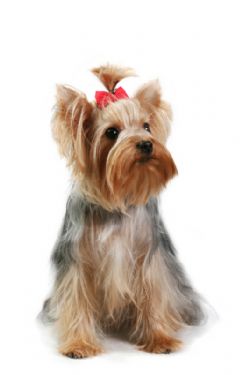Description
The Yorkie\'s long, glossy coat goes all the way to the ground and requires daily brushing. The hair on its head is usually tied up or parted down the middle all the way to the tail flowing straight and evenly on both sides. It has steal blue on the body and tail but tan everywhere else. There maybe be an almost gold color around the face. The head is small and somewhat flat. The muzzle isn\'t very long with a black nose. Eyes are medium sized and dark in color. The ears are small, V-shaped and carried erect. They are not too far apart, covered with short hair, and very deep in color usually a rich tan. The mouth is either a scissor or level bite. The neck has good reach while the body is compact with a level back. The tail is customarily docked to medium length with plenty of hair. The legs are straight and well covered in hair of rich golden tans ending a few shades lighter at the roots. The hair on the body is moderately long, and perfectly straight no waves. It has a glossy, silky texture. The hair on head and muzzle grow long to meet the length of the body. Some owners if not showing their Yorkie will keep the head trimmed.
History
The Yorkshire Terrier didn\'t begin as the fashionable and glamorous breed that they are today. They are a combination of so-called terrier breeds evolving from various terrier breeds. To best knowledge they think the Yorkshire was a crossbreed forming for the Waterside Terrier, Manchester Terrier, and Paisley Terrier. It got this name from all this taking place in Yorkshire, England.
In 1873, the kennel Club of England was formed. The Yorkshire Terrier joined the 40 selected Non-Sporting breeds under the name of Broken-Haired Scotch and Yorkshire Terriers. In the late 19th century the Yorkie made its popularity to the United States. Since then is has remained one of the most desired breeds.
Temperament
Although the Yorkshire Terrier is a small toy breed best know for his beautiful silky coat and spunky character, there are a lot of great things that make this breed so popular. The Yorkie is a fearless watchdog. They have a great sense of hearing and can usually hear someone coming long before they get to the door. The Yorkshire seems unaware of his small size. They are devoted to their owners. Most will prefer to share your bed if you allow. Full of energy they can keep up with kids. Because of their small size they might need more supervision with smaller children. They are eager to play and get into any trouble they might find. They have a mind of their own and this feisty, sweet little dog doesn\'t like to do anything he makes up his mind not to do! Even though is breed categorized as a toy there is still a lot of terrier left in them. They like to be busy, inquisitive, and bold. They can be aggressive towards animals so it is always a good idea to introduce with caution. While a toy, and at various times a greatly pampered one, the Yorkshire is a spirited dog that definitely shows its inner personality.
Thyroid Disease - Low Risk
The Yorkshire Terrier ranks #119 among all breeds for autoimmune thyroiditis prevalence. This is considered a low risk breed so your chances of obtaining a dog with the disease is small. It is still suggested that dogs meant for breeding still be tested to help bring the incidence of disease even lower (or even eliminate it).
| Rank Among Breeds |
Number of Dogs Tested |
Percent of Dogs With Disease |
| #119 |
3,083 |
2.5% |
You can download the full report (on all breeds) by the Michigan State University Diagnostic Center for Population and Animal Health. Here
Other Health Problems
Concerns in Health might be portosystemic shunt, collapsing tracheas, Legg Perthes disease, patellar luxation, and occasionally seen Progressive Retinal Atrophy. It is important to keep them current on immunizations and teeth cleanings. Because of their size they can be susceptible to fragile bones. High falls or jumps can lead to problems with joints. The "teacup" Yorkies can be even more prone to health concerns and behavioral problems.

